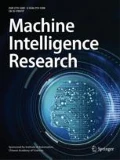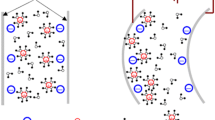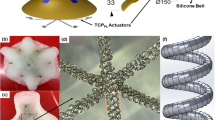Abstract
The paper addresses the designs of a caudal peduncle actuator, which is able to furnish a thrust for swimming of a robotic fish. The caudal peduncle actuator is based on concepts of ferromagnetic shape memory alloy (FSMA) composite and hybrid mechanism that can provide a fast response and a strong thrust. The caudal peduncle actuator was inspired by Scomber Scombrus which utilises thunniform mode swimming, which is the most efficient locomotion mode evolved in the aquatic environment, where the thrust is generated by the lift-based method, allowing high cruising speeds to be maintained for a long period of time. The morphology of an average size Scomber Scombrus (length in 310 mm) was investigated, and a 1:1 scale caudal peduncle actuator prototype was modelled and fabricated. The propulsive wave characteristics of the fish at steady speeds were employed as initial design objectives. Some key design parameters are investigated, i.e. aspect ratio (AR) (AR = 3.49), Reynolds number (Re = 429 649), reduced frequency (σ = 1.03), Strouhal number (St = 0.306) and the maximum strain of the bent tail was estimated at ε = 1.11% which is in the range of superelasticity. The experimental test of the actuator was carried out in a water tank. By applying 7 V and 2.5 A, the actuator can reach the tip-to-tip rotational angle of 85° at 4 Hz.
Similar content being viewed by others
References
P. Domenici, R. W. Blake. The Kinematics and Performance of the Escape Response in the Angelfish (Pterophyllum eimekei). Journal of Experimental Biology, vol. 156, no. 1, pp. 187–204, 1991.
R. C. L. Hudson. On the Function of White Muscles in Teleosts at Intermediate Swimming Speeds. Journal of Experimental Biology, vol. 58, no. 2, pp. 509–522, 1973.
Q. Bone, J. Kiceniuk, D. R. Jones. On the Role of Different Fiber Types in Fish Myotomes at Intermediate Swimming Speeds. Fish Bull, vol. 76, no. 3, pp. 691–699, 1978.
B. C. Jayne, G. V. Lauder. Red and White Muscle Activity and Kinematics of the Escape Response of Bluegill Sunfish During Swimming. Journal of Comparative Physiology A, vol. 173, no. 4, pp. 495–508, 1993.
J. Videler. Fish Swimming, 1st ed., Chapman & Hall, London, 1993.
D. C. Reid, B. Krimmer. A Fisherman Looks at Chum Salmon. Fish British Columbia Pro Talk, [Online], Available: http://www.bcadventure.com/adventure/angling/protalk/reid/chumsalmon.phtml, July 20–30, 2006.
S. Guo, T. Fukuda, K. Norihiko, O. Keisuke. Development of Underwater Microrobot Using ICPF Actuator. In Proceedings of the 1998 IEEE International Conference on Robotics and Automation, Piscataway, NJ, USA, pp. 1829–1834, 1998.
S. Michael, M. L. David, J. Bruce, C. Davies. Review of Fish Swimming Modes for Aquatic Locomotion. IEEE Journal of Oceanic Engineering, vol. 24, no. 2, pp. 237–252, 1999.
C. C. Lindsey. Form, Function and Locomotory Habits in Fish. Locomotion. Fish Physiology, W. S. Hoar, D. J. Randall, Eds., Academic Press, New York, vol. 7, pp. 1–100, 1978.
D. Barrett. Design of the MIT RoboTuna. MIT Towing Tank, [Online], Available: http://web.mit.edu/towtank/www/Tuna/Tuna1/design.html, July 10–20, 2006.
M. A. Jamie, A. K. Peter. The Vorticity Control Unmanned Undersea Vehicle (VCUUV): An Autonomous Robot Tuna. In Proceedings of 11th International Symposium of Unmanned Untethered Submersible Technology, Durham, NH, pp. 23–25, 1999.
M. S. Triantafyllou, A. H. Techet, Q. Zhu, D. N. Beal, F. S. Hover, D. K. P. Yue. Vorticity Control in Fish-like Propulsion and Maneuvering. Integrative & Comparative Biology, vol. 42, no. 5, pp. 1026–1031, 2002.
M. Mojarrad, M. Shahinpoor. Noiseless Propulsion for Swimming Robotic Structures Using Polyelectrolyte Ion Exchange Membrane. Smart Structures and Materials 1996: Smart Materials Technologies and Biomimetics, Proceedings of SPIE, vol. 2716, pp. 183–192, 1996.
S. Guo, T. Fukuda, K. Kosuge, F. Arai, K. Oguro, M. Negoro. Micro Catheter System with Active Guide Wire. In Proceedings of IEEE International Conference on Robotic and Automation, Piscataway, NJ, USA, vol. 1, pp. 79–84, 1995.
N Kato. Control Performance in the Horizontal Plane of a Fish Robot with Mechanical Pectoral Fins. IEEE Journal of Oceanic Engineering, vol. 25, no. 1, pp. 121–129, 2000.
K. Hirata. Prototype Fish Robot PF-300 To Study Turning Performance. National Maritime Research Centre of Japan, [Online], Available: http://www.nmri.go.jp/eng/khirata/fish/, July 25–30, 2006.
O. Nagato, K. Masahiro, M. Taya, C. Y. Wang. Design of Fish Fin Actuators Using Shape Memory Alloy Composites. Smart Structures and Materials Industrial and Commercial Applications of Smart Structures Technologies, Eric H. Anderson, Ed., Proceedings of SPIE, vol. 5388, pp. 305–312, 2004.
Y. Liang, H. Kato, M. Taya. Model Calculation of 3D Phase Transformation Diagram of Ferromagnetic Shape Memory Alloys. Mechanics of Materials, vol. 38, no. 5–6, pp. 564–570, 2006.
Y. Liang, Y. Kuga, M. Taya. Design of Membrane Actuators Based on Ferromagnetic Shape Memory Alloy Composite for Synthetic Jet Applications. Sensors and Actuators A: Physical, vol. 125, no. 2, pp. 512–51, 2005.
J. J. Videler. Fish Swimming, 1st ed., Chapman & Hall, London, pp. 113–116, p. 53, 1993.
R. W. Blake. Fish Locomotion, 1st ed., Cambridge University Press, Cambridge, 1983.
C. P. Van Dam. Efficient Characteristics of Crescent-shaped Wings and Caudal Fin. Nature, vol. 325, no. 6103, pp. 435–437, 1987.
J. J. Magnuson. Locomotion by Scombrus Fishes: Hydromechanics, Morphology and Behaviour. Locomotion. Fish Physiology, W. S. Hoar, D. J. Randall, Eds., Academic Press, New York, vol. 7, pp. 239–313, 1978.
P. W. Webb. Simple Physical Principles and Vertebrate Aquatic Locomotion. American Zoologist, vol. 28, no. 2, pp. 709–726, 1988.
G. S. Triantafyllou, M. S. Triantafyllou, M. A. Grosenbauch. Optimal Thrust Development in Oscillating Foils with Application to Fish Propulsion. Journal of Fluids and Structures, vol. 7, no. 2, pp. 205–224, 1993.
M. S. Triantafyllou, S. George. An Efficient Swimming Machine. Scientific American, vol. 272, no. 3, pp. 64–70, 1995.
P. W. Webb. Form and Function in Fish Swimming (Locomotor Qualities of Fish Behaviour). Scientific American, vol. 251, no. 12, pp. 58–68, 1984.
Author information
Authors and Affiliations
Corresponding author
Additional information
Tao Tao is pursuing his M.Eng. degree in mechanical engineering from the Department of Mechanical Engineering at University of Bristol, UK. He has spent a year abroad as an international exchange scholar at University of Washington (U.W.), Seattle, USA for 2005/2006. As he is studying in U.W., he has been working as a research assistant in Centre for Intelligent Materials and Systems, Department of Mechanical Engineering, U.W.
His research interests include bio-inspired modeling, Finite Element Analysis (FEA), Ferromagnetic Shape Memory Alloys (FSMA), and Micro Electro-Mechanical Systems (MEMS).
Yuan-Chang Liang received his M.Sc degree in mechanical engineering from Lehigh University, Bethlehem in 1998 and the Ph.D. degree in mechanical engineering from University of Washington in 2002. He is currently working as a research associate in the Center for Intelligent Materials and Systems at University of Washington, Seattle. He has been studying smart materials such as shape memory alloy (SMA) and ferromagnetic SMA.
His current research interests include intelligent materials and their applications including bio-inspired actuations.
Minoru Taya received his M.Sc degree in civil engineering and the Ph.D. degree in theoretical applied mechanics both from Northwestern University in 1973 and 1977, respectively. He taught at the University of Delaware as an assistant and associate professor from 1978–1985. He has been a professor of Mechanical Engineering, and adjunct professor of Materials Science and Engineering at the University of Washington since 1986. He has had visiting appointments at the University of Oxford, UK, Risø National Laboratory, Denmark, University of Tokyo, and Institute of Space and Aeronautical Science, Japan. During 1989–1991 he was a professor of Materials Systems, Department of Materials Processing, Tohoku University, Japan, where he supervised a number of research projects on processing composites. He is currently running a Center for Intelligent Materials and Systems (CIMS) as director, where he is involved in supervising a number of projects related to intelligent materials and systems.
His research interests include two major areas: 1) electronic packaging and composites, and 2) smart materials. In the former, he is working on designing, processing, characterizing a set of new electronic composites with emphasis on high thermal conductivity materials, while the materials in the latter area are piezoelectric composites, shape memory alloys and polymer gels which exhibit small to larger strain in this order under applied thermal and electromagnetic field. The smart materials are the key materials for high performance actuators, ranging from MEMS to artificial muscles.
Rights and permissions
About this article
Cite this article
Tao, T., Liang, YC. & Taya, M. Bio-inspired actuating system for swimming using shape memory alloy composites. Int J Automat Comput 3, 366–373 (2006). https://doi.org/10.1007/s11633-006-0366-4
Received:
Revised:
Issue Date:
DOI: https://doi.org/10.1007/s11633-006-0366-4




